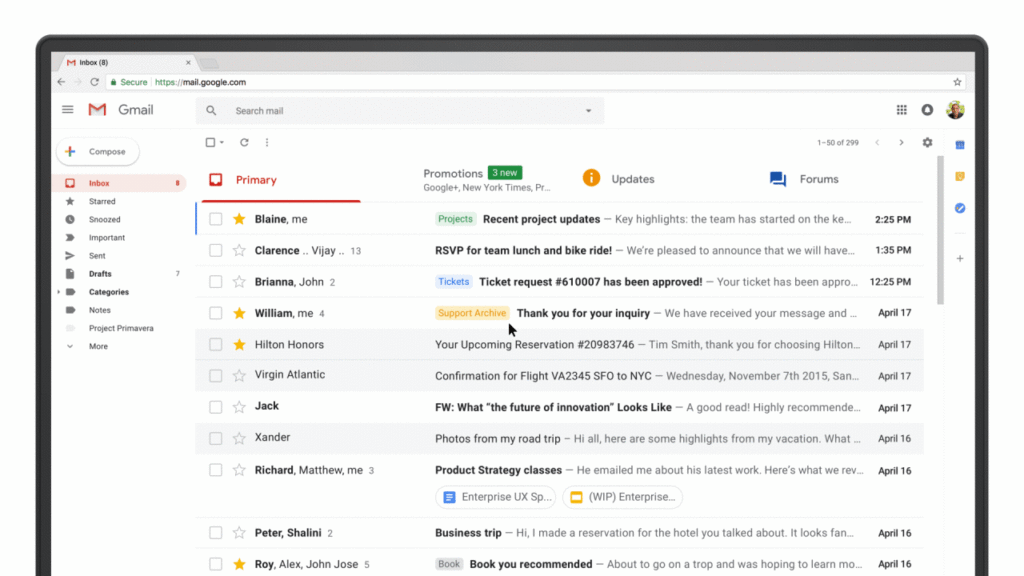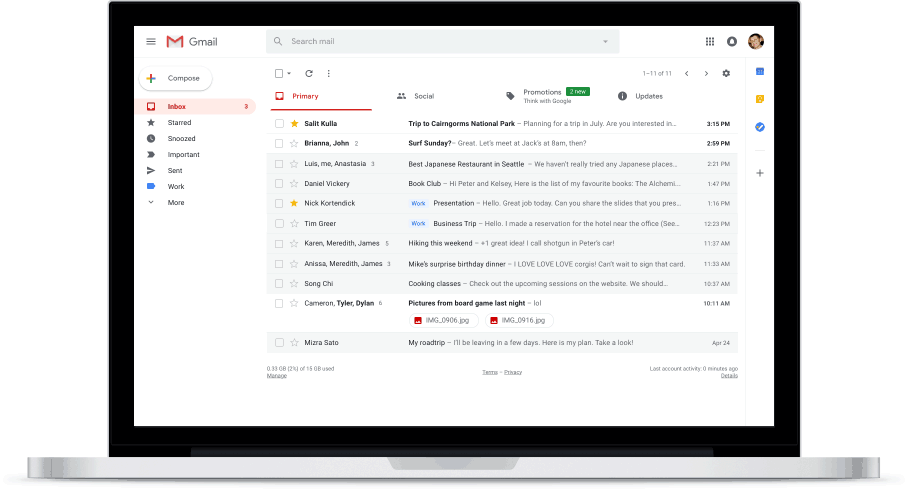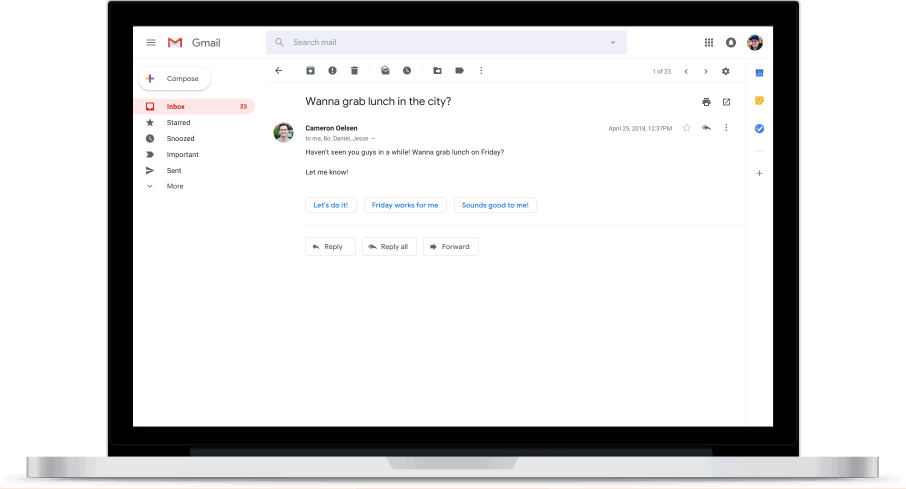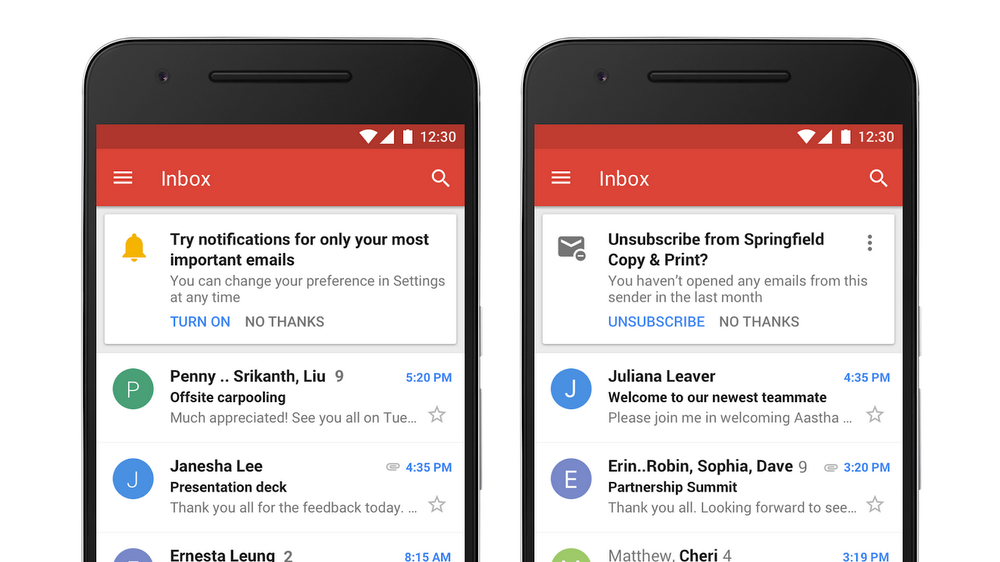Is Gmail Sabotaging Your Email Marketing?

Google introduced a new side panel
[caption id="attachment_86875" align="aligncenter" width="640"] Image Source: Google[/caption] What is it? In the new update, Gmail is integrating a side panel that allows users to easily access their Google Calendar, Tasks, and Google Keep content (Keep is an easy way to capture notes and lists.) You can also add other apps, like Asana or Trello. By dragging and dropping an email into Google Tasks, you can easily create a to-do item from an email message. How does this impact your email marketing? Google has said their recent updates will help users “do more without leaving the inbox.” The introduction of the side panel is likely to be a huge win for marketers, as your subscribers will be spending more time in Gmail, rather than split their time browsing different tabs. This could mean that your emails are more likely to be noticed, and earlier. Here are a few things your subscribers can now do easily:
Image Source: Google[/caption] What is it? In the new update, Gmail is integrating a side panel that allows users to easily access their Google Calendar, Tasks, and Google Keep content (Keep is an easy way to capture notes and lists.) You can also add other apps, like Asana or Trello. By dragging and dropping an email into Google Tasks, you can easily create a to-do item from an email message. How does this impact your email marketing? Google has said their recent updates will help users “do more without leaving the inbox.” The introduction of the side panel is likely to be a huge win for marketers, as your subscribers will be spending more time in Gmail, rather than split their time browsing different tabs. This could mean that your emails are more likely to be noticed, and earlier. Here are a few things your subscribers can now do easily:
- Receive an event or webinar invitation, or time-sensitive email from you and immediately check their calendar availability without ever leaving the inbox. If there’s an opening, they’re more likely to confidently opt-in to your invitation and note the date and time in their calendar.
- Receive a product offer or very important email that they wish to follow up on at a later date. Your subscribers can now drag that email into Tasks to create a to-do item to buy your product, engage with your service, or simply follow up.
- Take notes! You subscribers can use Google Keep to take notes and jot down insights from the content of your emails, without ever leaving the message.
Google could give your message a “nudge”
[caption id="attachment_86877" align="aligncenter" width="1000"] Image Source: Google[/caption] What is it? In this new suite of changes, Google has introduced an AI-powered “nudge” feature that might bump old emails back to the top of the inbox. Using artificial intelligence, Google can detect emails that are likely to require a response or follow up and push them to the attention of the users after some time has passed. How does this impact your email marketing? Ever send an awesome email to your subscribers asking a question, soliciting feedback, or inviting them to attend an event? Then… crickets. This feature has the potential to bubble your emails back up, and possibly at the most appropriate time. We don't have access to the exact algorithm Google is using to control this feature — how it knows when to "nudge" an email — but because Google has stated that their intent is to prevent things from “slipping through the cracks,” it’s likely that your engaged subscribers might get a “nudged” message when the content is time-sensitive and important.
Image Source: Google[/caption] What is it? In this new suite of changes, Google has introduced an AI-powered “nudge” feature that might bump old emails back to the top of the inbox. Using artificial intelligence, Google can detect emails that are likely to require a response or follow up and push them to the attention of the users after some time has passed. How does this impact your email marketing? Ever send an awesome email to your subscribers asking a question, soliciting feedback, or inviting them to attend an event? Then… crickets. This feature has the potential to bubble your emails back up, and possibly at the most appropriate time. We don't have access to the exact algorithm Google is using to control this feature — how it knows when to "nudge" an email — but because Google has stated that their intent is to prevent things from “slipping through the cracks,” it’s likely that your engaged subscribers might get a “nudged” message when the content is time-sensitive and important.
Subscribers can “snooze” your emails
[caption id="attachment_86878" align="aligncenter" width="908"] Image Source: Google[/caption] What is it? Nudging is awesome, but it’s controlled by Google’s artificial intelligence, not your actual subscribers. Within the new interface, Gmail users can optionally “snooze” your emails. This has been a popular feature with Google’s Inbox mobile app, as well as third party tools like Boomerang. Snoozing simply means that the email will no longer be in the inbox, and will re-appear at a time of your choice. This could be later within the same day, or possibly even a week. How does this impact your email marketing? It might feel like snoozing is a bad feature for marketers, possibly decreasing your open and click rates immediately after a send, or the same day. But it may actually be a great feature for you. After all, if your email is not sent at the optimal time for your subscriber, without the ability to snooze, they can only archive, delete, or even click SPAM. When a subscriber clicks “snooze,” however, they are not saying “no” to your email, they’re simply saying, “not right now.” As more users adopt this feature, may see your email engagement distributed more throughout the week after sending.
Image Source: Google[/caption] What is it? Nudging is awesome, but it’s controlled by Google’s artificial intelligence, not your actual subscribers. Within the new interface, Gmail users can optionally “snooze” your emails. This has been a popular feature with Google’s Inbox mobile app, as well as third party tools like Boomerang. Snoozing simply means that the email will no longer be in the inbox, and will re-appear at a time of your choice. This could be later within the same day, or possibly even a week. How does this impact your email marketing? It might feel like snoozing is a bad feature for marketers, possibly decreasing your open and click rates immediately after a send, or the same day. But it may actually be a great feature for you. After all, if your email is not sent at the optimal time for your subscriber, without the ability to snooze, they can only archive, delete, or even click SPAM. When a subscriber clicks “snooze,” however, they are not saying “no” to your email, they’re simply saying, “not right now.” As more users adopt this feature, may see your email engagement distributed more throughout the week after sending.
Google could suggest a response to your emails
[caption id="attachment_86879" align="aligncenter" width="906"] Image Source: Google[/caption] What is it? Another popular feature from Google’s Inbox app is suggested responses. Google’s AI will present users with a few suggestions for how to reply to an email they receive. This could be as simple as, “Sure!” or more detailed like “Friday works for me.” When a user clicks the response, it prompts a reply message with the content pre-filled, making quick replies easier than ever. How does this impact your email marketing? Email is a conversation. We recommend marketers treat it that way, rather than blast messages or push content out with “donotreply” reply-to addresses. There’s value in giving your subscribers the opportunity to answer questions, ask questions, provide feedback, get in touch with you, and let them know what’s on their minds. If Google provides the perfect contextual response to their emails, marketers may notice an increase in replies. This has the potential to branch into conversations with engaged potential customers, and the act of responding could also help both deliverability and inbox placement (getting your emails into the primary inbox for the subscribers that want it there.)
Image Source: Google[/caption] What is it? Another popular feature from Google’s Inbox app is suggested responses. Google’s AI will present users with a few suggestions for how to reply to an email they receive. This could be as simple as, “Sure!” or more detailed like “Friday works for me.” When a user clicks the response, it prompts a reply message with the content pre-filled, making quick replies easier than ever. How does this impact your email marketing? Email is a conversation. We recommend marketers treat it that way, rather than blast messages or push content out with “donotreply” reply-to addresses. There’s value in giving your subscribers the opportunity to answer questions, ask questions, provide feedback, get in touch with you, and let them know what’s on their minds. If Google provides the perfect contextual response to their emails, marketers may notice an increase in replies. This has the potential to branch into conversations with engaged potential customers, and the act of responding could also help both deliverability and inbox placement (getting your emails into the primary inbox for the subscribers that want it there.)
Google might recommend your subscribers to unsubscribe
[caption id="attachment_86880" align="aligncenter" width="1000"] Image Source: Google[/caption] What is it? Referenced specifically as a mobile feature, Google will now prompt users to unsubscribe from email newsletters they haven’t opened in a certain period of time. It’s unclear how this algorithm will work specifically, but it’s likely that Google’s AI will target newsletters that a user has completely lost interest in. How does this impact your email marketing? Now, your immediate reaction might be, “Curse you, Google!” But here's why you should be shouting, "Hallelujah!" or "Heck yeah!" or "Finally, Google gods!" Getting the right subscribers to unsubscribe from your email list is extremely good for you. Here’s why it’s a cause for celebration: When a subscriber disengages from your content — yet you continue to send to them —your open rates will decrease your deliverability may suffer (meaning, you hit the SPAM folder a lot more often), and you run the risk of having those subscribers inevitably marking one or more of your emails as SPAM. That’s right: Purging uninterested or unengaged subscribers is key to a successful email marketing strategy. (Here is how to clean your list in AWeber.) It’s recommended to re-engage dormant subscribers, and invite subscribers to opt out of your email list if they’ve lost interest or the content is no longer providing value. Gmail’s latest feature to encourage yields two possible benefits for marketers:
Image Source: Google[/caption] What is it? Referenced specifically as a mobile feature, Google will now prompt users to unsubscribe from email newsletters they haven’t opened in a certain period of time. It’s unclear how this algorithm will work specifically, but it’s likely that Google’s AI will target newsletters that a user has completely lost interest in. How does this impact your email marketing? Now, your immediate reaction might be, “Curse you, Google!” But here's why you should be shouting, "Hallelujah!" or "Heck yeah!" or "Finally, Google gods!" Getting the right subscribers to unsubscribe from your email list is extremely good for you. Here’s why it’s a cause for celebration: When a subscriber disengages from your content — yet you continue to send to them —your open rates will decrease your deliverability may suffer (meaning, you hit the SPAM folder a lot more often), and you run the risk of having those subscribers inevitably marking one or more of your emails as SPAM. That’s right: Purging uninterested or unengaged subscribers is key to a successful email marketing strategy. (Here is how to clean your list in AWeber.) It’s recommended to re-engage dormant subscribers, and invite subscribers to opt out of your email list if they’ve lost interest or the content is no longer providing value. Gmail’s latest feature to encourage yields two possible benefits for marketers:
- This change will undoubtedly encourage people who don’t want to be on your email list to no longer be on your email list. (And that’s a good thing.)
- This change will possibly remind dormant subscribers that they’re on your email list, which they do still want to be subscribed to, and encourage them to read future or past messages.
What do you think of the new Gmail changes?
So is Google sabotaging your email marketing efforts? Quite the opposite, in my opinion. As a long-time Gmail user, I welcome any usability improvements, and as an avid email marketer, I’m excited at the prospect of my audience spending more time in the inbox. After all, that's where my messages live. But I’m super curious what you think! Let me know in the comments below.The post Is Gmail Sabotaging Your Email Marketing? appeared first on Email Marketing Tips.
Contributer : Email Marketing Tips
Is Gmail Sabotaging Your Email Marketing?
![Is Gmail Sabotaging Your Email Marketing?]() Reviewed by mimisabreena
on
Wednesday, May 09, 2018
Rating:
Reviewed by mimisabreena
on
Wednesday, May 09, 2018
Rating:














No comments:
Post a Comment